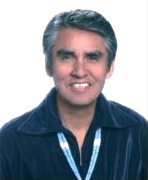|
| |||
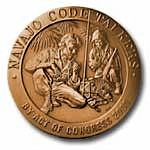
On July 26, 2001, President George W. Bush presented these golden medals to honor the 29
The Navajo Code Talkers played a vital role in the World War II Allies' victory in the Pacific. Using a code based on the complex Developed by the Original 29 Navajo Code Talkers This audio segment is provided by Mr. Richard K. Begay, Chief Staff Assistant for the Begaye/McKenzie Administration, the Navajo Nation. Mr. Begay is a veteran of the Vietnam War, serving two tours of duty in the I Corp region. He is a liaison and an Associate member of the Navajo Code Talkers Association. Source: of the Treasury at USMINT website |
proposed U.S. apology (The Daily Times Jul 11, 2004) WASHINGTON — Navajo Nation President Sen. Sam Brownback, R-Kan., regarding Shirley praised the senator’s effort to acknowledge the resentment many tribes continue to hold regarding past policies of termination, removal, relocation and neglect of trust obligations regarding the nation’s first Americans. “This joint resolution, I hope will start a process of review and dialogue on how future federal government policy development will further assist and support tribal self-determination efforts,” Shirley said “Sometimes a metaphorical clean slate is needed to build a better foundation for the future of relations between Native Nations and the United States.” The resolution was introduced by Brownback, and is currently supported by Tex Hall, Three Affiliated Tribes chairman and president of the National Congress of American Indians. The Senate Indian Affairs Committee approved the language on June 23 and now heads to the Senate floor. Its companion bill, H. J. 98, was introduced on June 18th. Among the main points of The offical site of the President & Vice President Washington Office By Mark Trahant, Seatle Post-Intelligencer columnist (Jul 31, 2004) |
|
an apology to all Native Peoples... (Hyperlinks by Mario Profaca) Who is going to apologize? It should be the president because of Recently this country marked the second anniversary of the terrorist attacks on the Twin Towers and the Pentagon. I keep hearing that this was the worst terrorist attack to happen in this country, but while my heart goes out to the dead, their families and those who are forever scarred by these events, there have been millions of people murdered in this country by terrorists. It would be impossible for me to list all of the You won't find many monuments to these, the unquiet dead. But their bones and blood make up the soil where your shopping centers and highways now stand. Where is their memorial? It is in the hearts of those who remember. Today I remember: The thousands of Cherokee, Chickasaw, Creek, Choctaw, Iroquois, Ojibway, Potawatomi, Seminole, Sioux & Chickasaw (and many others) who suffered untold agony during the forced removal from their homelands in the 1830's. Innocent men, women and little children perished in concentration camps or froze and starved to death on The 200 murdered Blackfeet women and children who died at The 103 Cheyenne women and children who were butchered on the Washita River in western Oklahoma. The 200 to 300 Sioux who were slaughtered under a flag of truce at The 500 Sauk and Fox Indians led by The Yuki's and other tribes of Indians in California whose populations declined from 11,000 to less than 1000 because white men wanted the land to search for gold. Organized Indian hunts were held on Sundays and our People were killed for sport. The little children who were kidnapped from their homes and forced to attend From the small pox, measles, typhoid, cholera, diphtheria, TB, and VD epidemics brought to us by the white invaders to And last but not least all the 2,000 Navajos who died during Sent to My Two Beads Worth from Dorinda Moreno with thanks. (July 2004) |

29, of Farmington, New Mexico. Todacheene died in Balad, Iraq, when mortar fire hit his guard post. He was assigned to 1st Battalion, 77th Armored Regiment, 1st Infantry Division, Schweinfurt, Germany. Died on April 6, 2004. (Fallen Heroes of Operation Iraqi Freedom) (Associated Press, ABQ Journal, April 7, 2004) (Gallup Independent, April 8, 2004) (The Arizona Republic, Apr. 9, 2004) (The Iraq Page, Apr. 12, 2004) 
(Science blog, Jun. 4, 2003) 23, of Tuba City, Arizona. Killed in action after her convoy was ambushed in Iraq on March 23, 2003. She was assigned to the 507th Maintenance Company, Fort Bliss, Texas. (Fallen Heroes of Operation Iraqi Freedom)
(The Arizona Republic) (The Arizona Republic, May 08, 2002) (Judy Nichols, The Arizona Republic, May. 2, 2003) (Reach Ruelas,The Arizona Republic, May 5, 2002) (The Arizona Republic, April 26, 2002) Arizona's own Lori Piestewa, an Army private killed in combat in Iraq, has become the nation's most recognizable Native American military icon. Lori Piestewa 
(Tulsa Native American Times, Jul. 27, 2004) Pfc. Lori Piestewa, the first Native American Indian woman killed in military service to the United States, in a March 23, 2003, ambush in Iraq. In honor of of slain Hopi servicewoman Lori Piestewa the name of an Arizona Mountain was changed from “Squaw Peak” to “Piestewa Peak” (The Arizona Republic, Nov. 12, 2003) (Seattle Post-Intelligencer, Jul. 21, 2004) (Kevin Pang, The Arizona Republic, Apr. 25, 2003) (Associated Press, Shiprock, 10/05/2003) |
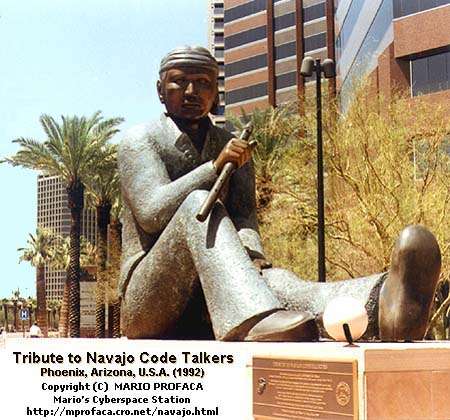 In his 1991 Senate resolution advocating a National Code Talkers Day, now celebrated every August 14, Senator Dennis DeConcini praised the Code Talkers' importance, saying, "Many Marines believe that Iwo Jima would never have been taken by American forces had it not been for the Navajo Code Talkers." According to an August 1981 headline in the Japanese newspaper the Fuji Evening News, "Japanese Military Forces Defeated by Indians, The Navajo Code Talkers, Revealed After 36 Years." Although the Code Talkers alone certainly could not have won the war, they provided Allied forces with an advantage unmatched. | |
 Navajo Code Talkers Navajo Code TalkersBy Yvette Lopez The People who were brutally forced off their homelands by the white man to take Paul, Doris A. The Navajo Code Talkers Philadelphia, Dorrance & Company, 1973. | |
|
by Colleen Brechting, Flora Gonzalez, MTH 380 A, April 10, 1998 The Navajo Indians also found problems in the war itself. They were sometimes mistaken for Japanese and taken prisoner. They would then have to prove that they were Navajo. Some Navajo’s had to have an escort so those mistakes like these were not made. After using the code in battle, they found a need for a larger vocabulary. They found that there were more words that they needed to use because of how frequently they found themselves spelling these words. They also had to make the alphabet larger, because if the Japanese figured how frequently each word was used they might figure out what letter was associated with it. So they contacted the Code Talker school and told them about their concerns. The school then made the vocabulary from 200 word to 400 words. They also made the alphabet much more difficult to decipher but adding more word to be associated with each letter. The more popular letters were given 3 word and less popular letters were given 2 words. This meant the code talkers had more memorizing to do. The The Navajo code talkers are know to have sent over 800 messages in a 2 day interval and all of the 800 messages that were sent in those two days not one had an error. V. After the War After the war when the Navajos returned home it seemed as though there was not as much harm done mentally to the code talkers as there had been to others that had served in the war. This is not because the Navajos didn’t fight because they were right in the middle of battle with the other soldiers. Also many of the code talkers were not used as code talkers when this program was first used, they just performed the duties of normal soldiers. At the end of World War II it was said that around 400 Navajos served the nation in this capacity. That is why it is surprising that it took the Government so long to recognize these soldiers, which turned out to be a very important part of the “Battle of the Islands.” Perhaps this is because the code was classified information until the late 1960’s. It was many years after the end of World War II before the The Navajo Code Talkers were also used in Korea in the 1950’s and in Vietnam in the 1960’s. This is how secure this code was it still was not broken during these wars. It also shows how much confidence that the military had in this system of coding. These code talkers were not nationally recognized until there was a reunion of the Fourth Marine Division Association in 1969. Then in 1971 President Nixon awarded a special certificate to the code talkers to thank them for their “patriotism, resourcefulness, and courage.” In early 1982, August 14,1982 was declared National Code Talkers Day, in honor of all the men who served in this capacity during the war. On September 17, 1992 the The Navajo Code Talkers made a major contribution to WWII. There is lesson that we can all learn from them. They kept their culture though out all the hardships. It is for this fact that the Navajo Code Talkers were such an asset to the U.S during WWII. If they would have given in to the white man, they wouldn’t have still had their language and the United States wouldn’t have an unbreakable code to look back on. |
|
Source: Navajo Code Talkers, Bibliography Aaseng, Nathan. Navajo Code Talkers. Canada: Thomas Allen & Son, 1992. Bixler, Margaret. Winds of Freedom: The Story of the Navajo Code Talkers of World War II. Darien: Two Bytes Publishing Company, 1992. Shepherdson, Nancy. America’s Secret Weapon. Boy’s Life. November 1997. P.45. Wilson, William. Code Talkers. American History. February 1997.pp.16(7). [http://www.history.navy.mil/faqs/faq61-4.htm] [http://www.history.navy.mil/faqs/faq61-2.htm] [http://wae.com/webcat/navajos.htm] |
|
By Beorge McColm, February 1997 While working as an agricultural expert for the Bureau of Indian Affairs after WW II, the author co-wrote a report that revealed the desperate plight of the Navajo people who lived on the brink of starvation in the American Southwest. "Inanition," a word unfamiliar to most people, was listed as the cause of death on many of the death certificates completed in 1947 by Navajo Service doctors who tended the residents of the Navajo Indian reservation in the Southwest United States. The word sounded better than its more descriptive meaning--"slow death by starvation"--to the federal agencies that since the Treaty of 1868 had been responsible for the care of the Navajo Nation. The euphemism's use helped to mask the sorry state of affairs that existed on the reservation at the end of World War II, a conflict in which many Navajos gallantly served the Allied cause. (full text) of Native American Codetalkers in WWI and WWII |
Live View This live image courtesy of www.sfpeaks.org Current View From Yavapai Point Grand Canyon National Park (Visual range is 75 miles)  This live image courtesy of http://www2.nature.nps.gov/air/WebCams/index.htm |
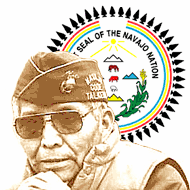
GOP delegate says The Washington state Republican Party has passed a resolution calling for the abolition of tribal governments. "We do not recognize them as sovereign nations, as governments," said John Fleming, the Skagit County delegate who was a main author of the resolution. It calls on the federal government to "immediately take whatever steps necessary to terminate all such non-republican forms of government on Indian reservations." "We think it can be done peacefully," Fleming said. But if tribes were to fight the effort, "then the U.S. Army and the Air Force and the Marines and the National Guard are going to have to battle back." (Full text) Originally Published in the Spokane.net on July 3, 2000 |
|
Marina, California (NETTIME-L) to John Flemming, Delegate Skagit County, skagitgop@cs.com To Delegate John Fleming, Regards the resolution you authored calling on the american government to abolish tribal governments, by whatever steps necessary to terminate all such non-republican forms of government on indian reservations. A news story has you stating... "then the US Army and the Air Force and the Marines and the National Guard are going to have to battle back." What you have said and what you intend to do is going to be reported around the world. You clearly have plans for the native people of Washington state and those plans are for the destruction of even more human beings. You are a Republican party delegate and so you speak for that party in this matter. It appears plain to me and to many others who have read the news story concerning this concept that you would try to unleash american military force upon the citizens of Washington state. John Fleming, you underestimate the american indian. You can not threaten humans with extinction without having it exposed to the world. Are you prepared to order in the military? I bet you are. You willing to set americans against americans? You clearly are. Why is that ? How can a person holding such a position in the Republican party have such a racist mindset? How did you come to have that position? This attempt by you to tear down the indian nations will just stir up a big mess for you. That is the certain result. I will do everything in my power to assure your comments about using the american military against american indians is broadcast around the world. James R. Burnes Cherokee, Marina, California Reflections of Traditionalists and Elders |
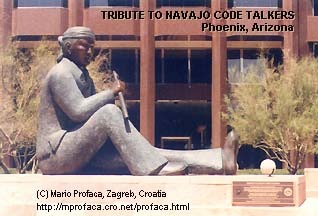 Navajo Code Talkers America's Secret Weapon in Defeating the Japanese in WWII. By Gerald Knowles Read Full text at Passages West, Mounument Valley web site. The war in the Pacific had just begun and the American forces were experiencing great difficulty in preventing the Japanese from anticipating their every move. The tenacity of the Japanese and the natural obstacles faced by the marines posed almost insurmountable problems to the retaking of those islands. It was critical to allied victory. Every communications code set up by the marines was eventually broken by the Japanese. It was only a matter of time. Most of the radio communications, essential to the direction of critical combat operations were being intercepted by the Japanese, many of whom could both understand English and sound like an American marine. 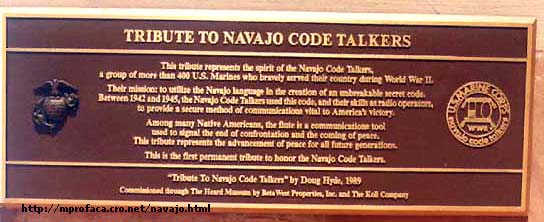 When the frustration and concern of the American command was reaching its most critical point, in walked a Navajo named Philip Johnston. As a boy, Philip had gone to Washington as a translator with a of Navajo and Hopi group to petition President Theodore Roosevelt for better resources for their tribes. In early 1942 Philip Johnston met with high ranking Marines at Camp Eliot in San Diego and presented the idea of using the Navajo language as a code. The American officers gave the project skeptical go ahead. It seemed too simple and vulnerable to have two soldiers talking back and forth to each other. 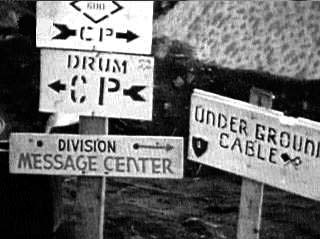 The initial reaction to recruiters who began circulating within one of the largest and most remote Indian nations in the United States was one of great suspicion. It was up to Chairman of the Navajo Nation, Chee Dodge, who sent word out about the mission of Navajo marines acting as special communication agents to assist the war effort. Notices were put up in trading posts all over the Navajo Reservation. Once the objective was understood, Navajo men, some of them only fifteen years old, rose to the occasion to assist the war effort and defend their country. Carl Gorman, Sr., the oldest of the Code Talkers is the father of famous Navajo artist R.C. Gorman of Taos, New Mexico. The first thirty recruits were selected. The first cadre of Navajo recruits coming from all directions in there faded jeans and dusty boots, some by horse back and some by wagon to board the trains at Flagstaff, Arizona and Gallup, New Mexico for marine base training camp in California. The initial reaction to recruiters who began circulating within one of the largest and most remote Indian nations in the United States was one of great suspicion. It was up to Chairman of the Navajo Nation, Chee Dodge, who sent word out about the mission of Navajo marines acting as special communication agents to assist the war effort. Notices were put up in trading posts all over the Navajo Reservation. Once the objective was understood, Navajo men, some of them only fifteen years old, rose to the occasion to assist the war effort and defend their country. Carl Gorman, Sr., the oldest of the Code Talkers is the father of famous Navajo artist R.C. Gorman of Taos, New Mexico. The first thirty recruits were selected. The first cadre of Navajo recruits coming from all directions in there faded jeans and dusty boots, some by horse back and some by wagon to board the trains at Flagstaff, Arizona and Gallup, New Mexico for marine base training camp in California.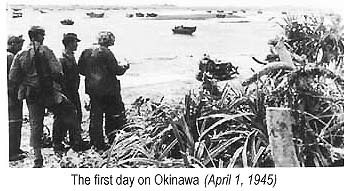 The Navajos arrived at boot camp. In 1943 there were 191
The Navajos arrived at boot camp. In 1943 there were 191 See also: The bloodiest battle of the Pacific War claimed more than 150,000 Japanese and American casualties. By John F. Wukovits (The Dineh') "In Beauty We Walk" by Gerald M. Knowles at Passages West (Mounument Valley) web site. |
Code Talkers Native American Participation in the United States Military Department of the Navy - Naval Historical Center Prepared for the United States Department of Defense by CEHIP Incorporated, Washington, DC, in partnership with Native American advisors, Rodger Bucholz, William Fields, Ursula P. Roach. Washington: Department of Defense, 1996. Code Talkers in World War II Code Talkers Medal of Honor Winners  Dictionary DictionaryREVISED AS OF 15 JUNE 1945, DECLASSIFIED UNDER DEPARTMENT OF DEFENSE DIRECTIVE 5200.9 (By L.C. Kukral, Navy & Marine Corps World War II Commemorative Committee. A service of Navy Chief of Information Office) Guadalcanal, Tarawa, Peleliu, Iwo Jima: the Navajo codetalkers took part in every assault the U.S. Marines conducted inthe Pacific from 1942 to 1945. They served in all six Marinedivisions, Marine Raider battalions and Marine parachute units,transmitting messages by telephone and radio in their nativelanguage--a code that the Japanese never broke.
|
(Cover) (Page 2) |
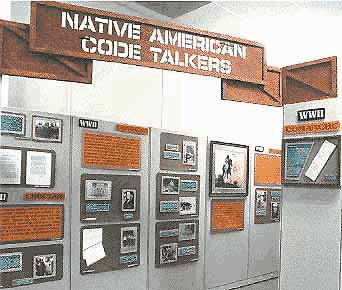 The U.S. Air Force is seeking to create a display for the Air Force Academy honoring Native Americans who served in the Air Force (or its predecessor, the Army Air Corps) between 1940 and 1997. Contact Professor Chadick by telephone at (719) 333-2416 or call Mr. S.S. Hampton, Sr. (Choctaw), Chair, Native American Special Observances at (719) 333-3430 or (719) 333-3431. Committee on Indian Affairs: Committee held oversight hearings to review Federal services and benefits designed to assist Native American veterans, receiving testimony from Jesse Brown, Secretary of Veterans Affairs; Espiridion Borrego, Deputy Assistant Secretary of Labor for Veterans' Employment and Training; Arcenio Smiley, Church Rock, New Mexico, on behalf of the Navajo Code Talkers Association; Apesanahkwat, Menominee Indian Nation, Keshena, Wisconsin; Anthony R. Pico, Viejas Band of the Kumeyaay Indian Reservation, Alpine, California; Samuel N. Penney, Nez Perce Tribal Executive Committee, Lapwai, Idaho; Kali Watson, Hawaii Department of Hawaiian Home Lands, Honolulu; and Ernie Stevens, Jr., National Congress of American Indians, Washington, D.C. (Hearings were recessed subject to call). |
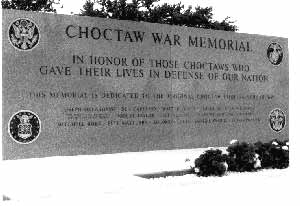 of World War I Click on the photo for an enlarged image -- 60 K From , The Official Publication of the Choctaw Nation, August 1986. In the closing days of World War I, eight Choctaws were instrumental in helping the American Expeditionary Force to win several key battles in the Mousse-Argonne campaign, which ... In the closing days of World War I, fourteen Choctaw Indian men in the Army's Thirty-Sixth Division, trained to use their language, helped the American Expeditionary Force win several key battles in the Meuse-Argonne Campaign in France, the final big German push of the war. 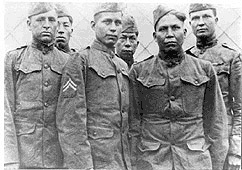 of World War I Click on the photo for an enlarged image -- 60 K. Memorandum from Colonel Bloor, 1919. Quohadi's Site. Comanche Lodge, Comanche Indians, Quanah Parker, Comanche Nation, Native American, Indian, Genealogy, Treaties Cultural Preservation Committee The Comanche Language and Cultural Preservation Committee PO Box 3610 Lawton, OK 73502 kanabuutsi@juno.com If you aren't on our mailing list and received a copy already, just e-mail your postal mailing address to kanabuutsi@juno.com. Why does the world need yet another book on D-Day? A good question. Consider the following contents and see if any other volume includes this information: 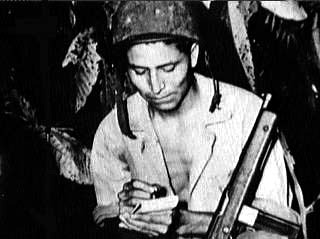
Paul Young George H. Kirk (left) fought on liberty's side in World War II. That in itself makes him special. But other reasons exist too. Whether thumbing through the December 1993 issue of Reader's Digest, perusing the August, 1993 issue of Smithsonian, or thoroughly reading Doris A. Paul's book The Navajo Code Talkers Navajo Code Talkers Paul's book The Navajo Code Talkers One Former Captive Knows By Tim Korte, Sanostee, New Mexico (AP) By the close of World War II, Army Sgt. Joe Kieyoomia shared something with the secret words employed by the Navajo Code Talkers: both were like granite against Japanese efforts to break them. Captured after the fall of the Philippines in 1942, Kieyoomia lived 43 months in Japanese prison camps. A member of New Mexico's famed 200th Coast Artillery unit, he survived the notorious Bataan Death March that killed thousands of starved U.S. soldiers. (full text) |
|
September 2, 1995, The White House, Office of the Press Secretary (Honolulu, Hawaii) 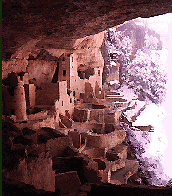 ... Our soldiers, believe it or not, trained with wooden rifles. But our enemies sold short the strength and will of the American people -- the grocery clerks and farmers; the students and salesmen; the short-order cooks and the factory workers; the whites; the blacks; the hispanics; the Asian-Americans who served, including |
|
The Daggett Museum consists of over 40 cases displaying Early American collectibles, Railroad China, Navajo Indian Code-talkers from WWII, Barbed wire, Lapidary work and much more, including a unique model of the Solar I Generating Plan. A Brief History Prepared by the Reference Section History and Museums Division, USMC, May 14, 1982 The Navajo Code Talkers Program was established in September 1942 as the result of a recommendation made the previous February by Mr. Philip Johnston to Major General Clayton P. Vogel, USMC., Commanding General, Amphibious Corps, Pacific Fleet, headquartered at Camp Elliott, California. Mr. Johnston, the son of a missionary to the Navajo tribe, was fluent in the language, having lived among the Navajos for 24 years. He believed that use by the Marine Corps of Navajo as a code language in voice (radio and wire) transmission could guarantee communications security. A service of Navy Chief of Information Office 695-3161/DSN 225-3161 - November 16, 1998 Cpl. Henry Bake Jr. (left) and Pfc. George H. Kirk operate a portable radio in Bougainville, the largest of the Solomon Islands. The two Navajo were members of a Marine corps unit that specialized in sending and receiving codes in the Navajo language during World War II. Associated Press, 06/25/98  CANONCITO, N.M. (AP) - Narciso "Ciso" Platero Abeyta, a painter of Navajo themes, died Monday of a stroke at age 79. Abeyta was a Code Talker during World War II, part of a group of Native Americans that conveyed sensitive encrypted information across enemy lines in the Pacific. The Navajo Code Talkers remained a classified top-secret of WWII until 1968. Although they played an essential role in the defense of this country, Code Talkers were not recognized for their heroic contribution until 1981, when Ronald Reagan publicly praised them for their dedication to duty and service during the war. Narciso Abeyta's death comes five months after the passing of Carl Gorman, Sr., said to be the eldest Code Talker that served in WWII. Gorman's son, the celebrated Southwest artist R.C. Gorman, sculpted a monument to the Code Talkers which can be seen in Arizona. (6/26/98) 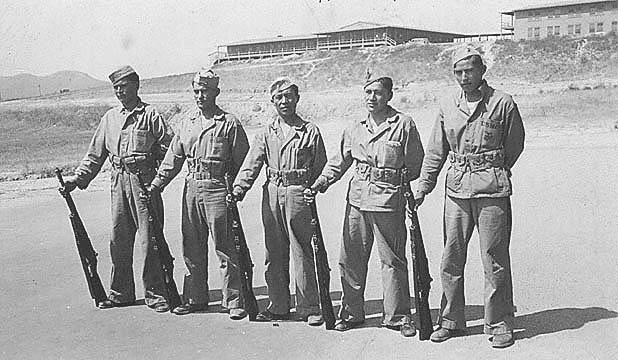 Photo of Navajo Code Talkers in formation at Camp Pendelton, California Local call number Philip Johnston Physical description Black-and-white photograph, 8 x 13.5 cm. Reproduction requires permission of the repository. Julie Butler, jbutler@sandia.gov , October 31, 1996 Sandia is a multiprogram laboratory operated by Sandia Corporation, a Lockheed Martin Company, for the United States Department of Energy. Albuquerque, N.M. -- U.S. military radio transmissions intercepted by Japanese intelligence during World War II were spoken in such an unusual lexicon that Japan regarded the Americans' "secret code" unbreakable. The code, based on the Navajo language, was used by a select group of Navajos from New Mexico and Arizona who served as signalmen with Marine combat units from May 1942 until the war's end. A new photography exhibit at the National Atomic Museum in Albuquerque (Wyoming Blvd. on Kirtland Air Force Base), titled "Warriors: Navajo Code Talkers," provides a glimpse into the contemporary lives of the 150-200 surviving code talkers. During World War II, the code talkers developed and used a system of fewer than 500 Navajo "code words" representing common military terms. The linguistic complexity of their language frustrated Japanese intelligence efforts, and many believe it played a significant role in the American offensive at Iwo Jima. |
|
at Navajo Community College - Encryption - Story Telling Reviewed in AFIO Weekly Intelligence Notes #43-99, 30 Oct 1999 AFIO - Association of Former Intelligence Officers, afio@his.com By Anna Mollo By Bill Papich, Chicago Tribune, March 17, 2000 GALLUP, N.M. - During World War II, they spoke the Navajo language as a code to confound Japanese eavesdropping on American military communications. Today, Hollywood and the country's second largest toy company listen to them. When the surviving Navajo code talkers meet once a month in this railroad and ranching town bordering the Navajo Nation, they talk about their newly found fame. Two major motion pictures about the Navajo code talkers are in the works, and last month toymaker Hasbro Inc. introduced Navajo Code Talker GI Joe, the company's first doll to speak a Native American language. "All of a sudden, the code talkers are starting to be known all over the world," says Frank Thompson, 79, who was among the 400 to 450 Navajo Indians entering the Marines from 1942 to 1944 who were trained as code talkers. Navajo is not a written language. That frustrated the Japanese who never broke the code and never captured a Navajo code talker. Until 1968, existence of the code talkers was classified. The Pentagon was unsure whether the Navajo language might be needed in another war. The importance of the Navajo language represented a turnaround for the code talkers, most of whom attended government schools on the Navajo Reservation. When they went to school students were punished if they spoke in Navajo, a practice that continued into the 1950s. Teddy Draper Jr., whose father was among the code talkers, credits them with starting a revival of the Navajo tongue. "They had been beating us down, and then they use our language to win the war," the younger Draper said. "In 1968, within months of declassification of the Navajo code, the Navajo people started pushing for their history, their culture and their language in the schools." (Full text) |
|
Navajo Nation Unofficial Web site with FAQ's About Life with Navajo People. Includes the Chinle/Central Navajo Nation Directory | Home of the Navajo People Navajos.Com: A thoroughly modern view of the Navajo community is provided at this site with an e-zine format. Feature articles are presented, along with a national calendar of events, a travel guide, links to resources, current weather, message boards, and chatroom. Native American Resources Listing of Native American related Internet Sites. Including Tribal Sites, Other Lists of links, Indian Health Services, Pow-Wow, and Native Recipes |


